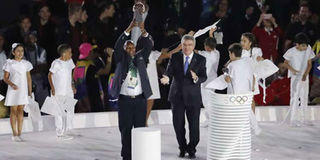Keino’s inspirational influence on generations of Kenyan athletes

Former athlete Kipchoge Keino (front, left) acknowledges his Olympic Laurel award as Thomas Bach (front, right), the president of the International Olympic Committee, applauds at the opening ceremony of the 2016 Summer Olympics in Rio de Janeiro on August 5, 2016. PHOTO | THOMAS COEX | AFP
What you need to know:
- I tell you what, if there were no Kipchoge Keino – known to one and all as Kip – Kenya’s middle- and long-distance athletics and athletes would not have developed, flourished and existed the way we know them today.
Kip has had an aspirational and inspirational influence and a positive and transformative impact on generations of Kenya’s athletes from Naftali Temu, Ben Jipcho, Amos Biwott, Robert Ouko, Hezekiah Nyamau, Julius Sang and Henry Rono in the 1960s and 1970s to their successors in the 1980s and 1990s.
Before the Rio Olympics kicked off, the International Olympics Committee on August 5 honoured Kipchoge Keino with its brand new Olympic Laurel award. It was a fitting tribute to the 76-year-old great of Kenya’s middle and long distance athletics.
Then, as the curtain fell on the games last week, Kenya’s national anthem bade all and sundry farewell, thanks to the gold medal won in the last event – the men’s marathon – by 31-year-old Eliud Kipchoge.
Yes, athletics takes Kenya to the world and brings the world to Kenya, both physically and figuratively. However, most Kenyans now are more likely to know the young marathoner than his septuagenarian namesake and predecessor.
I tell you what, if there were no Kipchoge Keino – known to one and all as Kip – Kenya’s middle- and long-distance athletics and athletes would not have developed, flourished and existed the way we know them today. Kip has had an aspirational and inspirational influence and a positive and transformative impact on generations of Kenya’s athletes from Naftali Temu, Ben Jipcho, Amos Biwott, Robert Ouko, Hezekiah Nyamau, Julius Sang and Henry Rono in the 1960s and 1970s to their successors in the 1980s and 1990s.
Kip has been a trainer, coach and adviser to many athletes. He has been the role model all – men and women – have wanted to be on the track, in management and in retirement. Humble Kip, who conquered the world in 1968 in Mexico City; focussed Kip who rose from a policeman to a global superstar; and simple, caring and generous Kip the multimillionaire businessman and farmer who is a world-acclaimed philanthropist.
Kip bagged the inaugural Olympic Laurel Award because of his “great contribution to Olympism in terms of culture, education, development and peace”. Kip runs a school for orphans; has a school for children in remote areas, a secondary school and the Kip Keino IAAF High Performance Training Centre, whose trainees and trainers come from all over the globe.
HEROIC ROLE
A forthcoming autobiography by sports journalist Omulo Okoth documents Kip’s heroic role in giving succour and sanctuary to survivors of the mayhem of the 2007/08 election violence in Uasin Gishu and Nandi counties. But Kip regards education as the first and foremost weapon of peace.
Something else about Kip’s Olympic Laurel award to buttress its massive importance and his equally substantial global stature. It is made of Fairmined Gold and it becomes the third so-fashioned trophy after the Nobel and the Palme d’Or. The latter is the highest prize at the Cannes Film Festival.
Is Kip therefore the prophet that is unrecognised at home? Well, there is the recently refurbished Kip Keino Stadium in Eldoret town. Kip is the chairman/President of the National Olympic Committee of Kenya. But this, it is my humble view, pales in comparison to what the man has done for his country.
In 1965, Kip broke the 3,000 and 5,000 metre world records. In 1968 he won the 1,500m Olympic gold, shattering the global expectation that record holder American Jim Ryun would carry the day. In 1972 Kip took on the steeplechase and set an Olympics record. Indeed, in the 1960s and through the 70s, Kip was better known around the world than Kenya. When he returned home, ministers, including Vice- President Daniel arap Moi, took turns to admire his medals.
But it is not these ministers, not even founding President Jomo Kenyatta, who captured Kip’s role in the national psyche in the way that thrills me. That belongs to athletics coach and teacher Bro Colm O’Connell, who counts David Rudisha among his charges. In Okoth’s upcoming book, he says:
“Kenya was a young republic hardly five years old since gaining political independence from Britain. As a young nation, Kenya was looking for somebody to stand up to, somebody who transcended ethnic boundaries, economic hardships and who towered above political wrangles. This is why the public saw Kip as somebody special.” May I humbly add that this is why the politicians regarded Kip as a national treasure.
As barefoot primary school going boys, we knew the fellows in our school and the neighbouring rivals who dominated the long races were Kipchoges. We were all silenced when Tanzania’s Filbert Bayi became the first African to beat Kip in his 1,500 metres specialty in the 1973 Lagos All Africa Games! So, we discovered, Kip was human after all.
He is, which is why the management of Kenya’s Rio Olympics team was shambolic and incompetent.





